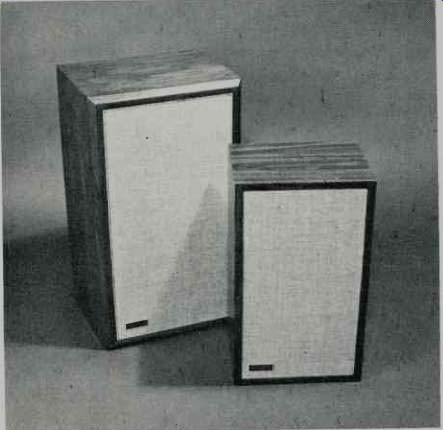If You Would Like Nothing Less Than the Best in Loudspeakers, But Doubt That You Can Afford Them, Please Read This Ad.

Both the loudspeakers shown--the original Advent Loudspeaker and The Smaller Advent Loudspeaker--are intended to be compared in audible performance, including frequency bandwidth, with the most elaborate and expensive speakers available. That may be difficult to accept, we realize, but it is true and verifiable in the listening.
Both Advent speakers were designed after more than fifteen years of experience in designing and manufacturing high-performance speaker systems, including some of those of other brands still held in highest regard by critical listeners. They were designed simply, out of knowledge that most complex, multi-speaker systems are the result of long-outdated notions that got their start when the first high-fidelity speakers for the home were adapted from the theater speakers of the 1940's. And they were designed to take advantage of new manufacturing techniques that had been developed over many years of experimentation.
Over-engineering needless elaboration of design in imitation of what has existed so far is a common problem in audio equipment, and one for which the customer often pays heavily in many ways. Good design to us is represented by the simplest approach that permits reaching a design objective without compromise.
Both Advent speakers are two-way systems.
A single speaker would be a more "ideal" device, but in practice has to give up either the frequency range or the power-handling needed for a no-compromise speaker. The use of several "full-range" speakers of any size doesn't preserve the theoretical advantage of a single speaker. And three-way and four-way systems are not only unnecessarily expensive and elaborate, but often inferior-sounding because of interference effects and abrupt electrical cut-off of drivers in different operating ranges. The two-way design is simple and effective, and both Advent systems exploit it more thoroughly than any previous speakers. No more elaborate design is capable of wider range or subtler characteristics.
Both Advent systems were also designed to waste nothing in imitation of theater speakers.
They are intended for use--heavy and hard use--in a home, not an auditorium or laboratory, and they include nothing but what is needed for the best possible performance in a home.
The original Advent Loudspeaker, which costs between $105 and $125 depending on its cabinet finish and the part of the country we have to ship it to, can withstand absolute, no holds-barred comparison with any speaker of any price, and sounds obviously and dramatically better than many far more expensive speakers. The Smaller Advent Loudspeaker ($70-$75) sounds the same as the original, but will not play quite as loud as the original in as big a living room.
We will be happy to send you a full explanation of the design of both Advent speakers.
Please write us at the address below and ask for our Speaker Packet, which includes reprints of reviews.
Thank you.
Advent Corporation, 195 Albany Street, Cambridge, Massachusetts 02139.
(Audio magazine, Dec. 1972)
Also see:
Advent--The Powered Advent Loudspeaker (Oct. 1977)
Advent "Smaller" Loudspeaker (Equip. Profile, Dec. 1972)
Advent New Vision Series loudspeakers (ad, Apr. 1991)
= = = =